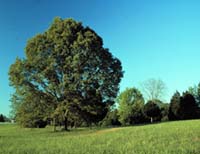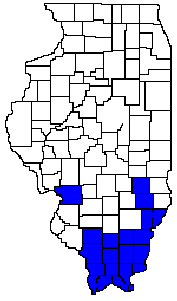 |
| Southern
Red Oak (Quercus falcata)
Distribution
Map to right |

Southern red oak is also referred to as Spanish oak. It is a large tree, up to 80 feet tall, with a trunk diameter of up to 4 feet. The crown is rounded and open, with spreading branches. It usually grows on well drained or dry, poor upland soils in southern mesic forests in Illinois. It also occurs occasionally in bottomlands in the state. Its range extends along the east coast from central New Jersey south to central Florida, west to eastern Texas and back east across central Missouri and south-central Illinois, through Indiana, Kentucky, and Tennessee.
Interesting Facts
Cherrybark oak (Quercus pagoda) is often treated as a variety of southern red oak. Whereas there are general morphological differences between the two, some of the characteristics that separate them can be variable. Spanish oak leaves, for example are usually 3 to 5 lobed, whereas cherrybark oak leaves usually have 5 to 11 lobes, but this characteristic is variable, with some southern red oak leaves having 5 or more lobes. Southern red oak leaves are more noticeably hairy below. Southern red oak bark is furrowed whereas the cherrybark oak bark is furrowed, but also broken into scales that give it the appearance of black cherry bark.
The two species have different habitat preferences. Cherrybark oak prefers poorly drained bottomland sites and mesic slopes in extreme the southern part of the state. Southern red oak prefers drier, poor upland soil, and is also present in the southern part of the state.
Identifying Features
Leaves
Southern red oak is in the red oak group. The leaves are alternate and simple, with 3 to 5 main, bristle-tipped, deeply incised lobes. The leaf base is usually rounded. Overall length of the leaf is from 5 to 9 inches and the width up to 6 inches. The surface of the leaf is green, and the underside has a mat of fine, pale yellow to gray hairs. Leaf stalks are up to 2 1/2 inches, and usually hairy.Flowers
Male and female flowers occur separately on the same tree, and appear when the leaves begin to appear. The male flowers are drooping, hairy catkins. Female flowers occur in rusty colored clusters and are also hairy.Fruits
The fruits, or acorns, are usually produced singly, biennially. They are 1/2 to 3/4 inch long, roughly spherical and orange-brown. The cup is thin and flat, and covers only about 1/4 to 1/3 of the nut. It has pale, reddish brown, densely hairy scales. Songbirds, turkey, a variety of small mammals and deer eat the nuts.
Uses
sSouthern red oak wood is heavy and strong. It is used for fence posts, fuel, and general construction. The tree is also planted as an ornamental, a good shade tree adapted to drier sites. Native Americans ate the acorns and utilized the southern red oak in a variety of ways to treat illness. The used it for indigestion, chapped skin, fever, asthma, and as an antiseptic and tonic for a wide range of illnesses.